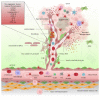Interactions between Platelets and Tumor Microenvironment Components in Ovarian Cancer and Their Implications for Treatment and Clinical Outcomes
- PMID: 36831623
- PMCID: PMC9953912
- DOI: 10.3390/cancers15041282
Interactions between Platelets and Tumor Microenvironment Components in Ovarian Cancer and Their Implications for Treatment and Clinical Outcomes
Abstract
Platelets, the primary operatives of hemostasis that contribute to blood coagulation and wound healing after blood vessel injury, are also involved in pathological conditions, including cancer. Malignancy-associated thrombosis is common in ovarian cancer patients and is associated with poor clinical outcomes. Platelets extravasate into the tumor microenvironment in ovarian cancer and interact with cancer cells and non-cancerous elements. Ovarian cancer cells also activate platelets. The communication between activated platelets, cancer cells, and the tumor microenvironment is via various platelet membrane proteins or mediators released through degranulation or the secretion of microvesicles from platelets. These interactions trigger signaling cascades in tumors that promote ovarian cancer progression, metastasis, and neoangiogenesis. This review discusses how interactions between platelets, cancer cells, cancer stem cells, stromal cells, and the extracellular matrix in the tumor microenvironment influence ovarian cancer progression. It also presents novel potential therapeutic approaches toward this gynecological cancer.
Keywords: angiogenesis; immune system; metastasis; ovarian cancer; platelet; thrombosis; tumor microenvironment.
Conflict of interest statement
The authors declare no conflict of interest.
Figures



References
-
- Etemadmoghadam D., Defazio A., Beroukhim R., Mermel C., George J., Getz G., Tothill R., Okamoto A., Raeder M.B., Harnett P., et al. Integrated Genome-Wide DNA Copy Number and Expression Analysis Identifies Distinct Mechanisms of Primary Chemoresistance in Ovarian Carcinomas. Clin. Cancer Res. 2009;15:1417–1427. doi: 10.1158/1078-0432.CCR-08-1564. - DOI - PMC - PubMed
-
- Jiménez-Sánchez A., Cybulska P., Mager K.L., Koplev S., Cast O., Couturier D.-L., Memon D., Selenica P., Nikolovski I., Mazaheri Y., et al. Unraveling tumor–immune heterogeneity in advanced ovarian cancer uncovers immunogenic effect of chemotherapy. Nat. Genet. 2020;52:582–593. doi: 10.1038/s41588-020-0630-5. - DOI - PMC - PubMed
Publication types
Grants and funding
LinkOut - more resources
Full Text Sources

